Delta Air Lines is one of the major airlines of the United States and a legacy carrier headquartered in Atlanta, Georgia.[1] The United States' oldest operating airline and the seventh-oldest operating worldwide,[7] Delta along with its subsidiaries and regional affiliates, including Delta Connection, operates over 5,400 flights daily and serves 325 destinations in 52 countries on six continents.[8][9] Delta is a founding member of the SkyTeam airline alliance.[9] As of the end of 2022, it had 90,000 employees.[10]
| |||||||
| Founded | March 2, 1925, as Huff Daland Dusters in Macon, Georgia | ||||||
|---|---|---|---|---|---|---|---|
| Commenced operations | June 17, 1929 | ||||||
| AOC # | DALA026A[1] | ||||||
| Hubs | |||||||
| Focus cities | |||||||
| Frequent-flyer program | SkyMiles | ||||||
| Alliance | SkyTeam/SkyTeam Cargo | ||||||
| Subsidiaries |
| ||||||
| Fleet size | 989 | ||||||
| Destinations | 311[4] | ||||||
| Traded as | |||||||
| ISIN | US2473617023 | ||||||
| Headquarters | Atlanta, Georgia, United States | ||||||
| Key people |
| ||||||
| Founder | C.E. Woolman | ||||||
| Revenue | |||||||
| Operating income | |||||||
| Net income | |||||||
| Total assets | |||||||
| Total equity | |||||||
| Employees | 103,000 (2023)[5] | ||||||
| Website | delta | ||||||
Delta has nine hubs, with Hartsfield–Jackson Atlanta International Airport being its largest in terms of total passengers and number of departures.[9] It is ranked second among the world's largest airlines by number of passengers carried, passenger-miles flown, and fleet size. It is ranked first by revenue for commercially owned airline companies as well as in brand value, and 113th on the Fortune 500.[11][12]
History
Early history
The history of Delta Air Lines began with the world's first aerial crop dusting operation called Huff Daland Dusters, Inc. The company was founded on March 2, 1925, in Macon, Georgia, before moving to Monroe, Louisiana, in summer 1925.[13] It flew a Huff-Daland Duster, the first true crop duster, designed to combat the boll weevil infestation of cotton crops.[14] C.E. Woolman, general manager and later Delta's first CEO, led a group of local investors to acquire the company's assets. Delta Air Service was incorporated on December 3, 1928, and was named after the Mississippi Delta region.[15][16][17]
Passenger operations began on June 17, 1929,[18] from Dallas, Texas, to Jackson, Mississippi, with stops at Shreveport and Monroe, Louisiana. By June 1930, service had extended east to Atlanta and west to Fort Worth, Texas.[19] Passenger service ceased in October 1930 when the airmail contract for the route Delta had pioneered was awarded to another airline, which purchased the assets of Delta Air Service. Local banker Travis Oliver, acting as a trustee, C.E. Woolman, and other local investors purchased back the crop-dusting assets of Delta Air Service and incorporated as Delta Air Corporation on December 31, 1930.
Delta Air Corporation secured an air mail contract in 1934, and began doing business as Delta Air Lines over Mail Route 24, stretching from Fort Worth, Texas, to Charleston, South Carolina.[19][20][13] Delta moved its headquarters from Monroe, Louisiana, to its current location in Atlanta in 1941.[21] The company name officially became Delta Air Lines in 1945.[22] In 1946, the company commenced regularly scheduled freight transport. In 1949, the company launched the first discounted fares between Chicago and Miami. In 1953, the company launched its first international routes after the acquisition of Chicago and Southern Air Lines.[23] In 1959, it was the first airline to fly the Douglas DC-8. In 1960, it was the first airline to fly Convair 880 jets. In 1964, it launched the Deltamatic reservation systems using computers in the IBM 7070 series. In 1965, Delta was the first airline to fly the McDonnell Douglas DC-9.
Growth and acquisitions
By 1970, Delta had an all-jet fleet, and in 1972 it acquired Northeast Airlines. Trans-Atlantic service began in 1978 with the first nonstop flights from Atlanta to London. In 1981, Delta launched a frequent-flyer program. In 1987, it acquired Western Airlines, and that same year Delta began trans-Pacific service (Atlanta-Portland, Oregon-Tokyo). In 1990, Delta was the first airline in the United States to fly McDonnell Douglas MD-11 jets. In 1991, it acquired substantially all of Pan Am's trans-Atlantic routes and the Pan Am Shuttle, rebranded as the Delta Shuttle. Delta was now the leading airline across the Atlantic.[17][24]
In 1997, Delta was the first airline to board more than 100 million passengers in a calendar year. Also that year, Delta began an expansion of its international routes into Latin America.[25] In 2003, the company launched Song, a low-cost carrier.[17]
Bankruptcy and restructuring (2005–2007)
On September 14, 2005, the company filed for bankruptcy, citing rising fuel costs.[26][27][28] It emerged from bankruptcy in April 2007 after fending off a hostile takeover from US Airways and its shares were re-listed on the New York Stock Exchange.[29][30][31]
Acquisition of Northwest Airlines (2008–2010)
The acquisition of Northwest Airlines was announced April 14, 2008. It was approved and consummated on October 29, 2008. Northwest continued to operate as a wholly owned subsidiary of Delta until December 31, 2009, when the Northwest Airlines operating certificate was merged into that of Delta.[32] Delta completed integration with Northwest on January 31, 2010, when their computer reservations system and websites were combined, and the Northwest Airlines brand was officially retired.[33]
Destinations and hubs
Destinations
Delta and its worldwide alliance partners operate more than 15,000 flights per day.[9] Delta is the only U.S. carrier that flies to Dakar, and along with competitors United Airlines and American Airlines, are the only two U.S. carriers that fly to Stockholm and Copenhagen, respectively.[34][35]
In March 2020, Delta suspended all flights to continental Europe for 30 days, and cut 40% of its capacity.[36]
Hubs
Delta currently has nine hubs:[9][37]
- Atlanta – The airline's largest hub serving the Southern and Eastern United States and as its main gateway to Latin America and the Caribbean. Home to Delta's corporate headquarters, as well as Delta TechOps, the airline's primary maintenance base.[38]
- Boston – Delta's secondary transatlantic hub. It offers service to destinations in Europe and North America.
- Detroit – One of Delta's two Midwest hubs. It is the primary Asian gateway for the Eastern United States and it also provides service to many destinations in the Americas and Europe. Former Northwest Airlines hub.
- Los Angeles – Delta's secondary hub for the West Coast. It offers service to cities in Latin America, Asia, Australia, Europe, and major domestic cities and West Coast regional destinations. With 20% of the airport's market share (in 2022), Delta is the largest carrier at LAX.[39]
- Minneapolis/St. Paul – One of Delta's two Midwest hubs. It is the primary Canadian gateway for the airline and also serves many American metropolitan destinations, a number of regional destinations in the upper Midwest, and some select destinations in Europe and Asia. Former Northwest Airlines hub.
- New York–JFK – Delta's primary transatlantic hub. The hub also offers service on transcontinental "prestige routes" to Los Angeles and San Francisco.
- New York–LaGuardia – Delta's second New York hub. Delta's service at LaGuardia covers numerous East Coast U.S. cities and a number of regional destinations in the U.S. and Canada.
- Salt Lake City – Delta's hub for the Rocky Mountain region of the United States. Delta service covers most major U.S. destinations and a number of regional destinations in the U.S., emphasizing on the Rocky Mountains and select destinations in Canada and Mexico, and select cities in Europe and Hawaii.
- Seattle/Tacoma – Delta's primary West Coast hub. The hub serves as an international gateway to Asia for the Western United States. Delta service also includes many major U.S. destinations as well as regional destinations in the Pacific Northwest.[40]
Delta is a member of the SkyTeam alliance and has codeshare agreements with the following airlines:[41][42]
- Aerolíneas Argentinas[43]
- Aeroméxico[44]
- Air Europa
- Air France
- airBaltic[45]
- China Airlines
- China Eastern Airlines
- Czech Airlines
- El Al[46]
- Garuda Indonesia
- Hawaiian Airlines
- ITA Airways[47]
- Kenya Airways[48]
- KLM
- Korean Air[49]
- LATAM Airlines[50]
- Rex Airlines[51]
- Seaborne Airlines[52]
- Sky Express[53]
- Transavia[54]
- Vietnam Airlines[55]
- Virgin Atlantic[56]
- WestJet[57]
Fleet

As of May 2024[update], the Delta Air Lines fleet consists of 989 mainline aircraft, making it the largest commercial airline fleet in the world.[58][59][60] Delta Air Lines operates a fleet manufactured by Airbus and Boeing.[61]
Delta operates the world's largest fleets of the Airbus A220, Boeing 717, and Boeing 757, the largest passenger fleet of the Boeing 767, and the largest Airbus A330 fleet of any US airline.
Delta has historically preferred purchasing or leasing used aircraft or using older-generation models to keep initial acquisition costs down. To support this business model, Delta has also invested in an extensive MRO (maintenance, repair, and overhaul) organization called TechOps. However, Delta has acquired lower-priced newer aircraft via discounts on slower-selling models and as aircraft manufacturers transition to newer designs. As a result, as of 2023,[update] Delta flies the second-oldest fleet among the legacy carriers, and the average fleet age has been reduced to 15.3 years.[62][63]
Before its 2008 merger with Northwest Airlines, Delta's fleet was made up of solely American manufacturers aircraft (except Airbus A310, which was acquired by collapsed Pan American World Airways). Overseas manufacturers aircraft like Airbus from Northwest joined the fleet after the merger, and more have since been added.Cabin
Delta underwent a cabin branding upgrade in 2015.[64] Availability and exact details vary by route and aircraft type.
- Delta One
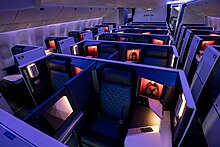
Delta One is the airline's premier business class product, available on long-haul international flights, as well as transcontinental service from New York–Kennedy to Los Angeles and San Francisco.[64]
Delta One features lie-flat seating on all aircraft types, and direct aisle access from every seat on all types except the Boeing 757-200 (in which only a special sub-fleet of approximately 20 aircraft feature lie-flats).[65] The Boeing 767-300ER seats, designed by James Thompson, feature a space-saving design whereby the seats are staggered such that when in the fully flat position, the foot of each bed extends under the armrests of the seat in front of it. On the Airbus A330 cabins, Delta One features the Cirrus flat-bed sleeper suite by Zodiac Seats U.S., configured in a reverse herringbone pattern.[66]
All seats are also equipped with a personal, on demand in-flight-entertainment (IFE) system, universal power-ports, a movable reading light, and a folding work table. Passengers also receive meals, alcoholic beverages, an amenity kit, bedding, and pre-flight Delta Sky Club access.[67]
In August 2016, Delta announced the introduction of Delta One Suites on select widebody fleets. The suites will feature a door to the aisle for enhanced privacy, as well as improved storage space, a larger IFE screen, and updated design. The suites rolled out on the Airbus A350 fleet, first delivered in July 2017, followed by installation within the Boeing 777 fleet.[68][69] Delta's Airbus A330-900, which began revenue service for the airline in July 2019, also features Delta One Suites.[70] Also in July 2019, Delta began retrofitting a new seat on the 767-400ER, which featured increased privacy and design similar to Delta One Suites, though without a privacy door.[71] These seats lack a door due to the 767's smaller cabin width.
- Premium Select

In April 2016, Delta CEO Ed Bastian announced that a new Premium Economy cabin will be added. Since renamed to Premium Select, this cabin will feature extra legroom; adjustable leg rests; extra seat pitch, width, and recline; and a new premium service. Delta introduced it on its new Airbus A350, first delivered in fall 2017, to be followed by the now-retired Boeing 777.[72] In October 2018, Delta announced that it would be selling first class seats on domestically configured Boeing 757 aircraft flying transatlantic routes as Premium Select.[73] Delta's A330-900, delivered in 2019, also offers Premium Select.[74] In 2021, Delta began retrofitting many of its 767-300ER and older A330 aircraft with Premium Select.[75]
- First Class
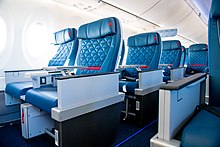
First Class is offered on mainline domestic flights (except those featuring Delta One service), select short- and medium-haul international flights, and Delta Connection aircraft. Seats range from 18.5 to 20.75 inches (47.0 to 52.7 cm) wide and have between 37 and 40 inches (94 and 102 cm) of pitch. Passengers in this class receive a wider variety of free snacks compared to Main Cabin, as well as free drinks and alcohol, and full meal service on flights 900 miles (1,400 km) and longer. Certain aircraft also feature power ports at each seat and free entertainment products from Delta Studio. First Class passengers are also eligible for priority boarding.[67]
- Delta Comfort+
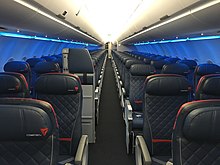
Delta Comfort+ seats are installed on all aircraft and feature 34–36 inches (860–910 mm) of pitch; on all Delta One configured aircraft, 35–36 inches (890–910 mm) of pitch and 50 percent more recline over standard Main Cabin seats.[76] Additional amenities include: priority boarding, dedicated overhead space, complimentary beer, wine, and spirits on flights 250 miles (400 km) or more, and complimentary premium snacks on flights 900 miles (1,400 km) or more. Complimentary premium entertainment is available via Delta Studio, with free headsets available on most flights.[67] On transcontinental flights between JFK-LAX/SFO, Delta Comfort+ passengers also get Luvo snack wraps. Certain Medallion members can upgrade from Main Cabin to Comfort+ for free right after booking, while other customers can upgrade for a fee or with SkyMiles.[77]
- Main Cabin

Main Cabin (Economy Class) is available on all aircraft with seats ranging from 17 to 18.6 inches (43 to 47 cm) wide and 30 to 33 inches (76 to 84 cm) of pitch. The main cabin on some aircraft have an articulating seat bottom where the seat bottom moves forward in addition to the seat back tilting backwards when reclining.[68][78]
Main Cabin passengers receive complimentary snacks and non-alcoholic drinks on all flights 250 miles (400 km) or longer. Alcoholic beverages are also available for purchase. Complimentary meals and alcoholic drinks are provided on long-haul international flights as well as selected transcontinental domestic flights, such as between New York–JFK and Seattle, San Francisco, Los Angeles, and San Diego.[79][80] As part of Delta's Flight Fuel buy on board program, meals are available for purchase on other North American flights 900 miles (1,400 km) or longer.[79]
Delta operated a different buy on board program between 2003 and 2005.[81][82] The previous program had items from differing providers, depending on the origin and destination of the flight.[83][84] Prices ranged up to $10 ($16.13 when adjusted for inflation). The airline started the service on a few selected flights in July 2003, and the meal service was initially offered on 400 flights.[85] Delta ended this buy on board program in 2005; instead, Delta began offering snacks at no extra charge on flights over 90 minutes to most U.S. domestic flights and some flights to the Caribbean and Latin America. Beginning in mid-March 2005 the airline planned to stop providing pillows on flights within the 48 contiguous U.S. states, Bermuda, Canada, the Caribbean, and Central America. In addition, the airline increased the price of alcoholic beverages on Delta mainline flights from $4 ($6.24 when adjusted for inflation) to $5 ($7.8 when adjusted for inflation); the increase in alcohol prices did not occur on Song flights.[85]
- Basic Economy
Basic Economy is a basic version of Main Cabin, offering the same services with fewer flexibility options for a lower price.[64] Examples of fewer flexibility options include no ticket changes, no paid or complimentary upgrades regardless of frequent-flier status, and only having a seat assigned at check-in.[86] As of December 2021, Basic Economy travelers no longer earn award miles (used for redeeming free travel, for example) or medallion qualifying miles (which count towards elite status).[87]
Reward programs
SkyMiles
SkyMiles is the frequent flyer program for Delta Air Lines. Miles do not expire but accounts may be deactivated by Delta in certain cases, such as the death of a program member or fraudulent activity.[88]
Delta Sky Club
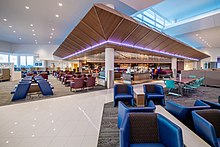
Delta Sky Club is the branding name of Delta's airport lounges. Membership is available through an annual membership that can be purchased with either money or miles. International passengers traveling in Delta One class get free access. Membership can also be granted through top-level Delta status or by being an American Express cardholder with certain exceptions. As of January 2019, Delta no longer offered single-day passes.[89]
Originally, Delta's membership-based airport clubs were called Crown Room lounges, with Northwest's called WorldClubs.
Exclusive Delta One Clubs for customers traveling in business class are slated to open at New York–Kennedy, Los Angeles, and Boston in 2024.[90][91]
In February 2024, Delta announced a new, more exclusive or premium level of Sky Club lounge aimed at high-spending travelers. The first would be at New York's John F. Kennedy International Airport, followed by those in Boston's Logan International Airport and Los Angeles International Airport later in the year. In addition to wellness areas, the lounge would offer a full-service brasserie and a marketplace influenced or assisted by a chef that would feature an open kitchen. The move represented a shift away from a standard offering to something closer to a unique experience for each airport and the city in which the lounge was located.[92][93][94]
SkyBonus
On November 27, 2001, Delta Air Lines launched SkyBonus,[95] a program aimed toward small-to-medium businesses spending between $5,000 and $500,000 annually on air travel.[96] Businesses can earn points toward free travel and upgrades, as well as Sky Club memberships and SkyMiles Silver Medallion status. Points are earned on paid travel based on a variety of fare amount paid, booking code, and place origin or destination.[97] While enrolled businesses are able to earn points toward free travel, the traveling passenger is still eligible to earn SkyMiles during his or her travel.[97]
In early 2010, Delta Air Lines merged its SkyBonus program with Northwest's similar Biz Perks program.[97]
Corporate affairs
Business trends
The key trends for Delta Air Lines are (as of the financial year ending 31 December):[98]
| Year | Revenue in billion US$[a][b] | Net income in billion US$[b] | Total assets in billion US$[b] | Price per share in US$ [citation needed] | Employees[b] | Passenger load factor (%)[b] | Fleet size[c] | Refs. |
|---|---|---|---|---|---|---|---|---|
| 2005 | 16.4 | −3.8 | 20.0 | 76.5 | [99] | |||
| 2006 | 17.5 | −6.2 | 19.6 | 78.5 | [100] | |||
| 2007 | 19.1 | 1.6 | 32.4 | 18.56 | [101] | |||
| 2008 | 22.6 | −8.9 | 45.0 | 9.47 | 81.4 | [102] | ||
| 2009 | 28.0 | −1.2 | 43.7 | 7.53 | 81,106 | 82.0 | 983 | [103] |
| 2010 | 31.7 | 0.6 | 43.1 | 12.60 | 79,684 | 83.0 | 815 | [104] |
| 2011 | 35.1 | 0.9 | 43.4 | 9.29 | 78,400 | 82.1 | 775 | [105] |
| 2012 | 36.6 | 1.0 | 44.5 | 10.07 | 74,000 | 83.8 | 717 | [106] |
| 2013 | 37.7 | 10.5 | 52.2 | 20.00 | 78,000 | 83.8 | 743 | [107] |
| 2014 | 40.3 | 0.7 | 54.0 | 37.61 | 80,000 | 84.7 | 772 | [108] |
| 2015 | 40.7 | 4.5 | 53.1 | 46.11 | 83,000 | 84.9 | 809 | [109] |
| 2016 | 39.6 | 4.3 | 51.2 | 43.11 | 84,000 | 84.6 | 832 | [110] |
| 2017 | 41.2 | 3.5 | 53.2 | 49.98 | 87,000 | 85.6 | 856 | [111][112] |
| 2018 | 44.4 | 3.9 | 60.2 | 54.50 | 89,000 | 85.5 | 871 | [113][114][115] |
| 2019 | 44.0 | 4.7 | 64.5 | 55.30 | 91,000 | 86 | 898 | [116][117] |
| 2020 | 17.0 | −12.3 | 71.9 | 34.97 | 74,000 | 55 | 750 | [118][98] |
| 2021 | 29.8 | 0.3 | 72.4 | 42.82 | 83,000 | 69 | 816 | [119][98] |
| 2022 | 50.5 | 1.3 | 72.2 | 32.86 | 95,000 | 84 | 902 | [120][121] |
| 2023 | 58.0 | 4.6 | 73.6 | 103,000 | 85 | 958 | [122] |
Personnel
Between its mainline operation and subsidiaries, and as of March 2015, Delta employs nearly 80,000 people.[9] Ed Bastian is the current chief executive officer and has served in this position since May 2, 2016.[123] Joanne Smith is Executive Vice President and Chief People Officer responsible for the oversight and support of personnel needs at Delta. She was appointed on October 1, 2014, replacing Mike Campbell.[124]
Delta's 14,500 mainline pilots are represented by the Air Line Pilots Association, International and are the union's largest pilot group.[125][126] The company's approximately 180 flight dispatchers are represented by the Professional Airline Flight Control Association (PAFCA).[127] Not counting the pilots and flight dispatchers, Delta is the only one of the five largest airlines in the United States, and one of only two in the top 9 (the other being JetBlue), whose non-pilot USA domestic staff is entirely non-union.[125] In August 2020, as a result of the COVID-19 pandemic, Delta Air Lines announced that it would be cutting 1,941 pilot job positions if it could not conclude a cost reduction deal with its union.[128] In January 2021, Delta said that, thanks to the federal support, it will be able to bring back 400 pilots in full time.[129]
Delta Global Staffing
Delta Global Staffing (DGS) was a temporary employment firm located in Atlanta, Georgia. Delta Global Staffing was a wholly owned subsidiary of Delta Air Lines, Inc., and a division of the internal company DAL Global Services.
Delta Air Lines sold majority ownership of DAL Global Services to Argenbright Holdings on December 21, 2018. As part of the sale, Delta dissolved the staffing division of DGS.[130]
It was founded in 1995 as a provider of temporary staffing for Delta primarily in Atlanta. DGS has since expanded to include customers and businesses outside the airline and aviation industries. DGS now supports customers in major US metropolitan areas.
Delta Global Staffing provided contract workers for short and long term assignments, VMS partnering, VOP on-site management, temp-to-hire, direct placements, and payroll services. DGS services markets such as call centers, customer services and administrative placements, IT & professional recruiting, logistics, finance & accounting, hospitality, and aviation/airline industry.[131]
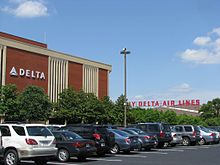
Headquarters and offices
Delta's corporate headquarters is located on a corporate campus on the northern boundary of Hartsfield–Jackson Atlanta International Airport, within the city limits of Atlanta.[132][133][134] This location has served as Delta's headquarters since 1941, when the company relocated its corporate offices from Monroe, Louisiana, to Greater Atlanta.[135][136] The crop dusting division of Delta remained headquartered in Monroe until Delta ceased crop dusting in 1966.[17] Before 1981, the Delta corporate campus, an 80-acre (32 ha) plot of land in proximity to the old Hartsfield Airport terminal, was outside the City of Atlanta limits in unincorporated Fulton County. On August 3, 1981, the Atlanta City Council approved the annexation of 141 acres (57 ha) of land, an area containing the Delta headquarters. As of 1981 Delta would have had to begin paying $200,000 annually to the City of Atlanta in taxes. In September 1981, the airline sued the city, challenging the annexation on the basis of the constitutionality of the 1960 City of Atlanta annexation of the Hartsfield old terminal.[137] The City of Atlanta was only permitted to annex areas that are adjacent to areas already in the Atlanta city limits.[137]
In addition to hosting Delta's corporate headquarters, Hartsfield–Jackson is also the home of Delta TechOps, the airline's primary maintenance, repair, and overhaul arm and the largest full-service airline MRO in North America, specializing in engines, components, airframe, and line maintenance.[138]
Delta maintains a large presence in the Twin Cities, with over 12,000 employees[139] in the region as well as significant corporate support functions housed in the Minneapolis area, including the company's information technology divisional offices.[140]
Corporate identity
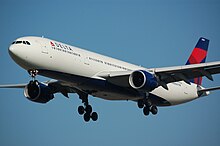
Delta's logo, often called the "widget", was originally unveiled in 1959. Its triangle shape is taken from the Greek letter delta, and recalls the airline's origins in the Mississippi Delta.[141] It is also said to be reminiscent of the swept-wing design of the DC-8, Delta's first jet aircraft.[142]
Delta's current livery is called "Upward & Onward". It features a white fuselage with the company's name in blue lettering and a widget on the vertical stabilizer. Delta introduced its current livery in 2007 as part of a re-branding after it emerged from bankruptcy. The new livery consists of four colors, while the old one (called "colors in motion") used eight. This meant the switch saved the airline money by removing one day from each aircraft's painting cycle. The airline took four years to repaint all of its aircraft into the current scheme, including aircraft inherited from Northwest Airlines.[141]
Environmental initiatives
In 2008, Delta Air Lines was given an award from the United States Environmental Protection Agency's Design for the Environment (DfE) program for its use of PreKote, a more environmentally friendly, non-hexavalent chromium surface pretreatment on its aircraft, replacing hazardous chemicals formerly used to improve paint adhesion and prevent corrosion. In addition, PreKote reduces water usage by two-thirds and reduces wastewater treatment.
PreKote is also saving money by reducing the time needed to paint each airplane. With time savings of eight to ten percent, it will save an estimated more than $1 million annually.[143]
Despite having purchased 9.7 million metric tonnes of carbon offsets in 2022, Delta was in the process of moving away from such investments to reduce the company's carbon footprint by the end of March of that year and was instead focusing on reducing emissions from company operations.[144] In May 2023, Delta Air Lines received a consumer class action lawsuit filed in Central California U.S. District Court over marketing claims that the company is the world's first carbon neutral airline.[145][146][147]
In popular culture
Deltalina
As part of the re-branding project, a safety video featuring a flight attendant was posted on YouTube in early 2008, getting over 1 million views and the attention of news outlets, specifically for the video's tone mixed with the serious safety message. The flight attendant, Katherine Lee, was dubbed "Deltalina" by a member of FlyerTalk for her resemblance to Angelina Jolie.[148][149] Delta had considered several styles for its current safety video, including animation, before opting for a video presenting a flight attendant speaking to the audience. The video was filmed on a former Song Airlines Boeing 757-200.[150]
On-time performance
In 2023, Delta flights arrived at their destination on time 84.72% of the time, compared to the North American industry average of 74.45% per Cirium. Delta completed 98.82% of its scheduled flights.[151]
Accidents and incidents
The following are major accidents and incidents that occurred on Delta mainline aircraft. For Northwest Airlines incidents, see Northwest Airlines accidents and incidents. For Delta Connection incidents, see Delta Connection incidents and accidents.
All told, in 14 fatal accidents involving at least one death, 299 passengers and crew died, 11 on two other aircraft died (in two collision accidents), and 16 persons on the ground died (in four accidents).[152]
For a more detailed list of the accidents:
- Flight 4
- Flight 10
- Flight 705
- NC49657
- Flight 1903
- N4875C
- Flight 9877
- Flight 843
- Flight 841
- Flight 9570
- Flight 954
- Flight 723
- Flight 516
- Flight 523
- Flight 1080
- Flight 1061
- August 23, 1980 Hijacking
- September 13, 1980 Hijacking
- Flight 722
- Flight 784
- Flight 357
- Flight 191
- Flight 1141
- Flight 1554
- Flight 1581
- Flight 1288
- Flight 554
- Flight 12
- Flight 1989
- Flight 89
- Flight 1111
- Flight 2348
See also
Notes
References
- Notes
- Bibliography
- Green, William; Swanborough, Gordon; Mowinski, John (1987). Modern Commercial Aircraft. New York: Crown Publishers, Inc. ISBN 0-517-63369-8.
External links
- Official website
- Delta Air Lines companies grouped at OpenCorporates
- Business data for Delta Air Lines:






